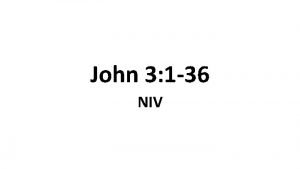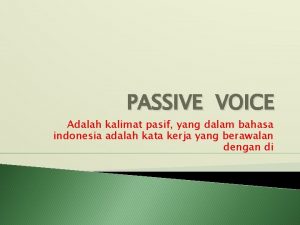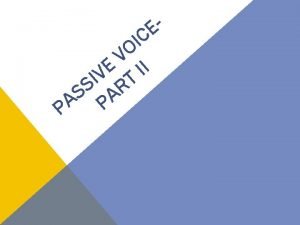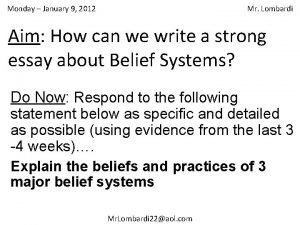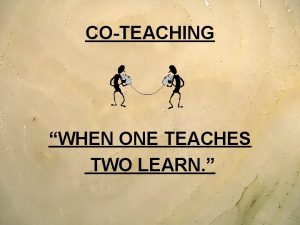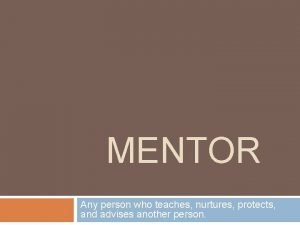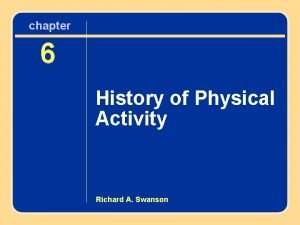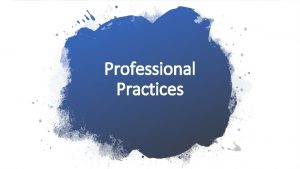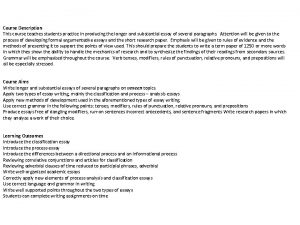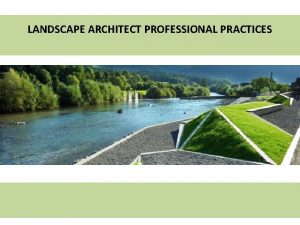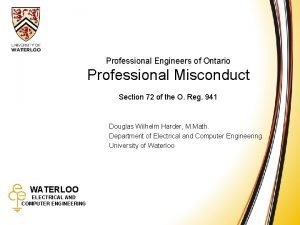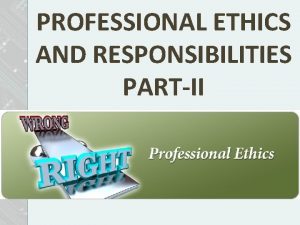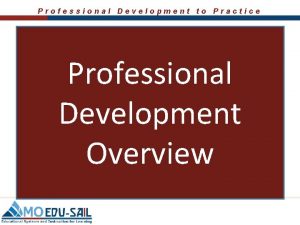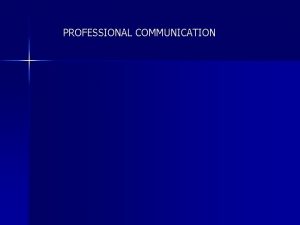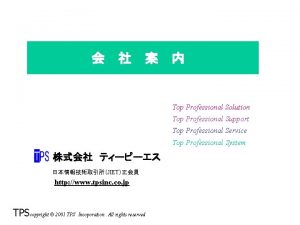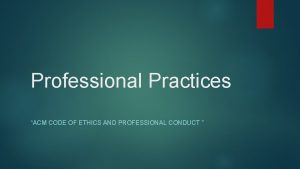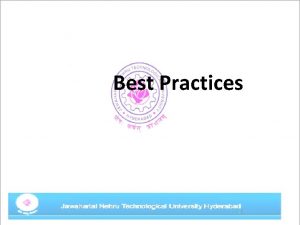Professional Practices 1 Professional Practices This course teaches

















- Slides: 17

Professional Practices 1

Professional Practices • This course teaches you professional software development practices not consistently taught anywhere else. • Deals mostly with process, very little with specs/designs/coding. • If you have the aptitude of becoming a professional software engineer you will find the course fascinating. • Otherwise I guarantee you will be bored! • Applying these practices will help you avoid • • • Missed dates Poor quality software Badly-designed features Poor user documentation Poor architecture and architectural documentation Dysfunctional professional relationships between “The Business Side” and Software Development • When software is built in a professional fashion in industry, this is how it is consistently done. 2

Experience • Need • Formal education in the computing sciences • Professional experience • Build software that lots of people pay money to buy • Not just “are you paid” • Not all professionals agree on what constitute “basic professional practices” • Characteristic of an immature industry • But can agree on the problems we are trying to solve • One (informed) opinion will be presented here 3

Top-10 Essential Practices source code control infrastructure reproducible builds defect/feature tracking automated regression testing release planning control feature specifications refinement architectural control effort tracking process control business planning 4

Defining the Profession • Today’s professions are composed of three interlinking parts. These include the discipline, which defines the forward and academic view of the field (the field is defined, in this case, to be inclusive of all three parts); the practice defining experiential and agreed upon practices; and the profession, that combines elements of both to provide a consistent view of the field and the expectations of the members from an external point of view. Discipline Profession Practice 5

Discipline • The discipline is inclusive of all ideas that are grouped under the same field. This grouping is around generally recognized schools of thought that describe the field. The discipline is aware of how the profession is practiced but is not prescriptive to the processes, tools and standards that apply to how the profession is actually practiced. Practice • Practice is based in reflection-in-action. Practitioners have many experiences as they develop and mature as enterprise architects. Through their experiences, they apply knowledge to new, unexpected, and changing situations. Profession • Professional status is a newer aspect of a field that combines the academic rigor of a discipline and a practice, while adding the exclusionary access that was reserved for a craft. The key difference between a profession and either a craft, discipline, or practice is its customer facing view and changing situations. 6

There are certain attributes of a profession that are consistent through all of the literature. a) There is a statement of ethics on how the profession is responsible to society. b) There is a approving body that has the ability to remove professional status from those who transgress professional standards. c) Each profession tests for competency. d) Professions maintain their link to the advanced knowledge within their industry. e) The people within the profession have unique expertise that cannot be found outside the profession. 7

Some General Provisions for Practice requirements 1. Aim and tasks of professional practice • Practice is constituent and integral part of the international business management studies. Aim: To strengthen theoretical knowledge acquired during courses of the study program, to form and to develop skills and abilities in accordance with requirements of stated competencies of international business manager. Tasks: 1. 2. 3. 4. Practically to get familiar with principles of international company’s management in micro and macro environment To carry out analysis of international company’s activities and their results To elaborate proposals for improvement of international company’s activities To do applied research work related to final paper. 8

Correlation between goals of study programme and practice • The goals of study programme (subjects) which will be pursued during the practice will be indicated from the catalogue of each subject • Goals of the practice will be formulated alongside each goal of study programme 9

2. Process of organization and management of practice • Practice takes place at the 6 th semester of studies. • During professional practice a student works in a company with a profile corresponding to the study program – international business management. • Tri-lateral agreement between the Company, the Institution, and the Student is signed before starting practice. • Student prepares plan of the practice with guidance of the practice supervisor and in accordance with Practice Programme Before starting practice. The plan is signed by company’s practice supervisor, institutional practice supervisor and students-trainee. 10

3. Duties 3. 1. Duties of student – trainee. • To get familiar with program of professional practice and to fulfil tasks described in the program • To confirm with the company’s internal rules during practical placement period in the company • To make notes in practice diary in accordance with prepared plan of the practice • To fulfil individual tasks and instructions given by company’s practice manager • To elaborate and to defend practice report in accordance with content of practice 11

3. 2. Duties of institutional practice supervisor • To confirm plan of practice elaborated by the student if it corresponds with requirements of program of professional practice • To control if student follows realisation of practice program • To provide necessary consultations • To promote and to control student’s research for development of useful proposals development for the company • To check and to sign report of professional practice 12

3. 3. Duties of company’s practice supervisor • To confirm plan of practice elaborated by the student if it corresponds with requirements of program of professional practice • To provide student with appropriate working place and conditions for realization of practice program • To support student’s applied research work • To confirm professional practice report and to evaluate in written work of student – trainee during practice, to sign and to stamp it. 13

4. Volume, layout, defence and evaluation of practice • At the end of professional practice report must be prepared and practice must be defended. Volume of report should be not less then 20 pages (without appendixes). • Practice report consists of: • Title page, • Contents, • Introduction: place, time, aim, tasks and methods of research. • Description of basic issues in accordance with detailed practice program • Conclusions and suggestions • References • Appendixes 14

WHAT IS PROFESSIONAL PRACTICE? • Recognizing and respecting variety in understandings of practice. • Considering the important role played by translators and interpreters in facilitating and promoting international communication and understanding, • Seeking to ensure that a high level of professionalism is achieved and maintained in translating and interpreting, 15

Developed countries establishing a framework to drive professional practice improvements There are four components • Professional Practice Programme (PPP) • Professional Practice Initiatives (PPI) • Communities of Interest (Cof. I) • Communities of Practice (Co. P) 16

• Some Review Questions related to today lecture: 1. How we make out the Public Trust? ? 2. In profession architects 1. 2. 3. 4. Which standards are accepted into the profession? List out their capabilities. How they can achieve recognition inside and outside their community? How they mature into the profession? 17
 John 3:36 niv
John 3:36 niv Romeo and juliet theme
Romeo and juliet theme What game theory teaches us about war
What game theory teaches us about war I delivered goods to my friends
I delivered goods to my friends Mr sullivan teaches us grammar
Mr sullivan teaches us grammar Change the voice ms sullivan teaches us grammar
Change the voice ms sullivan teaches us grammar The buddhist religion teaches that salvation is earned by
The buddhist religion teaches that salvation is earned by When one teaches, two learn
When one teaches, two learn A person who teaches
A person who teaches History of physical activity teaches us about
History of physical activity teaches us about Which major religion teaches conformity a caste system
Which major religion teaches conformity a caste system Big bang theory math
Big bang theory math A short tale that teaches a lesson
A short tale that teaches a lesson 7 disney values
7 disney values Course title and course number
Course title and course number T junction in english bond
T junction in english bond Course interne course externe
Course interne course externe Computer contracts in professional practices
Computer contracts in professional practices
